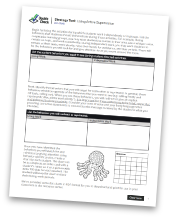Strategy: Using Active Supervision
Check-Up Menu > Using Active Supervision
How To
How to Use Active Supervision in Your Classroom
- First, identify the activities, groupings, and projects your students engage in that are not teacher directed (e.g., cooperative learning groups, peer-assisted learning, independent work).
- Next, identify the behaviors students should engage in to be successful during these activities. Determine the voice level, movement, and engagement expectations. These will be the behaviors you target with behavior-specific praise (e.g., “You have worked persistently and are using your time well.“).
- Next, identify the signs of typical off-task behavior or misbehavior (e.g., students gesturing, talking, out of seat or out of area) and determine how you will respond to these behaviors (e.g., redirect, verbal reprimand, logical consequence).
Example Videos:
Video Prompts:
- This video demonstrates a teacher using dot charts during active supervision.
- Notice how the teacher comments on the student’s work, provides feedback, and then puts a dot on the student’s chart. When the chart is full, the student knows they will earn a reward.
- How might using dot charts with your students help keep them engaged in their work?
- What did you like about the way the teacher used active supervision here?
- How might you incorporate some of what you saw in this video into your daily teaching?
Video Prompts:
- Notice how the teacher moves around the room between the desks, commenting on the work she sees as she goes.
- Notice how the teacher provides behavior-specific praise (“I see very neat and pretty writing. Good job.“).
- How do you think the way the teacher moved around the room and commented on the work helped to keep students on task?
- What did you like about the way the teacher actively supervised the students’ work?
- What could you do to make it easier for you to move around your classroom and use active supervision?
Video Prompts:
- Notice how the teacher checks in with each student as they do independent work.
- She comments on their work, provides feedback as needed, and gives a lot of praise privately to each student.
- How do you think the students felt as the teacher privately gave each praise or commented on their work?
- What did you like about the way the teacher used active supervision here?
- How might you incorporate some of what you saw in this video into your daily teaching?
Strategy Tool

Reflection

Goal Setting

References to Other Relevant Resources:
Reinke, W. M., Herman, K. C., & Sprick, R. (2011). Motivational interviewing for effective classroom management: The classroom check-up. New York, NY: Guilford Press.
Stormont, M., W. M. Reinke, Herman, K. C., & Lembke, E. (2012). Academic and behavior supports for at-risk students: Tier 2 interventions. New York, NY: Guilford Press.
Sprick, R. (2009). CHAMPS: A proactive and positive approach to classroom management. Eugene, OR: Pacific Northwest Publishing.
Sprick, R., Knight, J., Reinke, W., Skyles, T., & Barnes, L. (2010). Coaching classroom management: Strategies and tools for administrators and coaches. Eugene, OR: Pacific Northwest Publishing.